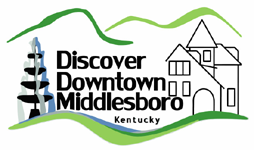 |
| Members of the DDM Design Committee in front of the Elks Home which they are working to restore. |
Middlesborough, Kentucky (June 24, 2014) – Discover
Downtown Middlesboro has been designated
as an accredited National Main Street
Program for meeting the commercial district revitalization performance
standards set by the National Main Street Center®, a subsidiary of the National
Trust for Historic Preservation. Each year, the National Main Street Center
and its partners announce the list of accredited Main Street® programs in recognition of
their exemplary commitment to historic preservation and community
revitalization through the Main Street Four Point Approach®.
“We congratulate this year’s nationally accredited Main
Street programs for their outstanding accomplishment in meeting the National
Main Street Center’s performance standards,” says Patrice Frey, President &
CEO of the National Main Street Center. “Accredited Main Street programs create vibrant
communities by using a comprehensive strategy to preserve their historic
character and revitalize their commercial districts, which helps make these
great places to work, live, play and visit.”
The organization’s performance is annually evaluated by the Kentucky Main Street Program, which works in partnership with the National Main Street Center to identify the local programs that meet ten performance standards. These standards set the
benchmarks for measuring an individual Main Street program’s application of the
Main Street Four Point Approach® to commercial district revitalization.
Evaluation criteria determines the communities that are building comprehensive
and sustainable revitalization efforts and include standards such fostering
strong public-private partnerships, securing an operating budget, tracking programmatic
progress and actively preserving historic buildings.
 |
| Certificate recognizing DDM as a nationally certified Main Street program. |
In 2013 Discover Downtown Middlesboro reported $2.7 million
of investment downtown, 13 new businesses created, and over 100 new jobs.
During that same period of time the organization managed to attract over
$150,000 in grants to carry out a strategic planning process, to build a trail
connecting the downtown with the National Park, and to assist with
pre-development work on the Elks Home which the organization has owned since
December 2012. These accomplishments were recognized at the National Main
Streets Conference in Detroit this past May when Middlesboro was one of two
communities nationally named “Ones to Watch.”
Discover Downtown Middlesboro is a 501(c)3 non-profit organization
that was founded in 2006. Since that time the organization has worked to
spearhead revitalization of the downtown area. This is accomplished through
coordinating grassroots action by volunteers on four committees - Organization,
Promotion, Design, and Economic Restructuring. Some recent DDM projects include
organizing the Christmas Parade and decoration of the downtown, addition of
four fountains and seating at Cumberland Avenue and 20th Street, and
encouraging the restoration of several buildings downtown.
Established by the National Trust
for Historic Preservation in 1980, the National Main Street Center helps
communities of all sizes revitalize their older and historic commercial
districts. Working in more than 2,200 downtowns and urban neighborhoods over
the last 34 years, the Main Street program has leveraged more than $59.6 billion
in new public and private investment. Participating communities have
created 502,728 net new jobs and 115,381 net new businesses, and rehabilitated
more than 246,158 buildings, leveraging an average of $33.28 in new investment
for every dollar spent on their Main Street district revitalization efforts.
###

